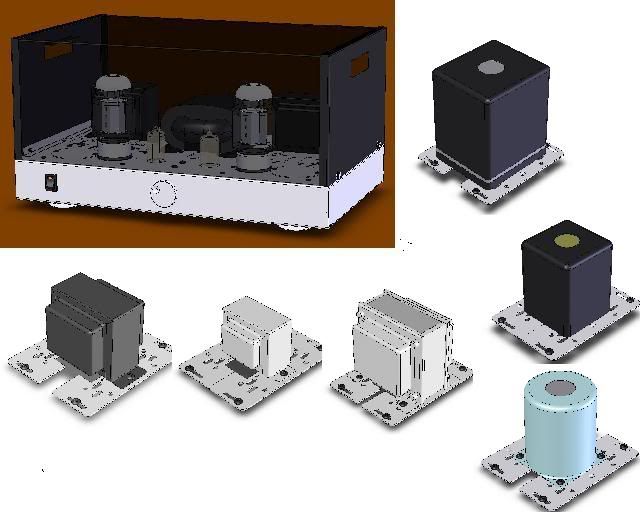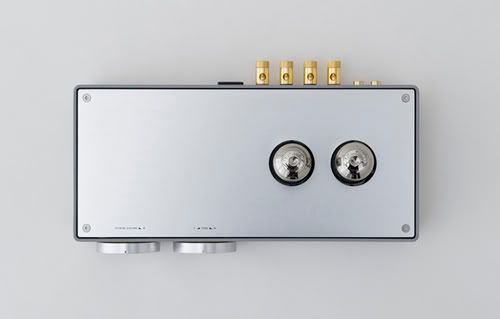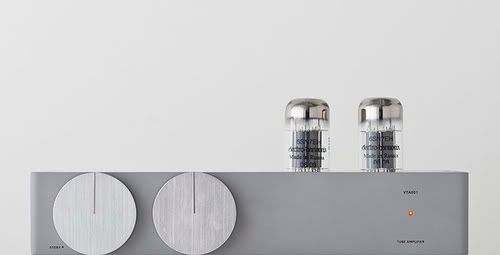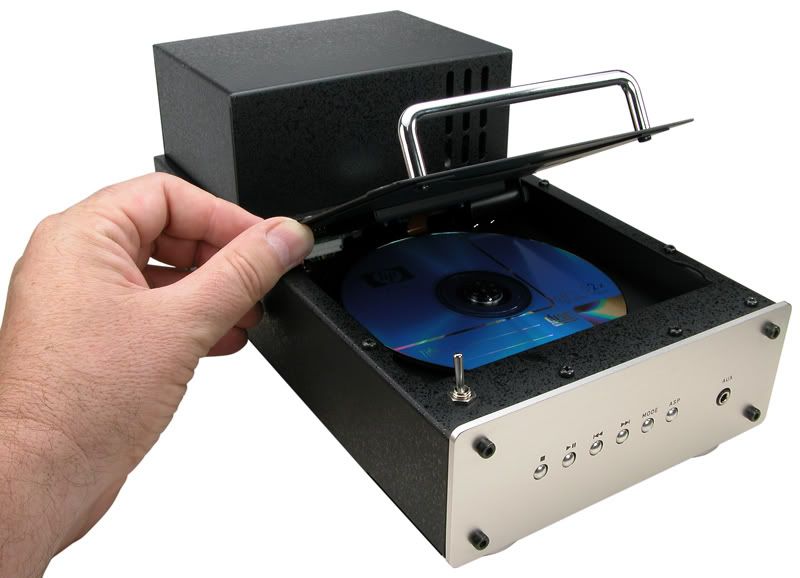Some time ago, triode12 happened to be passing through Fukuoka and while here, mentioned that Elekit, whom I had previously only heard of as a maker of electronic kits, had their factory here and that they made a headphone amplifier kit. I hadn't made an effort to look them up straight away, as I had assumed that when I found them, they'd be far from where I live, involving a long drive, as Fukuoka prefecture is not at all small and I am not confident enough in my Japanese, especially about anyting technical. Imagine my surprise when I found that their factory is almost just around the corner from my apartment and their PR person speaks fluent English!
So, having found a time when we were both free, LobsterSan and I made our way to their factory, headphones in hand, to try their headphone amp, the TU-882R. I would have loved to try a pair of K1000s or a Stax driver unit out of their speaker amps, but alas we have neither. So it was my Grado HF2s and HD-800s with an APureSound cable, along with Elekit's 600 Ohm K241s which we had to try the TU-882R with.

The entrance lobby of the Elekit factory is a large public area where a number of their kits have been assembled, from small robots to all sorts of gadgets. As one enters, one can heard bird-like noises from tiny kits hanging from the leaves of the plastic plants, and what looked like an orange eye ball with legs clicks on and off in reaction to noise, recording our voices. A large table contains assembled robots that can be played with, and the walls are lined with purchasable kits and demo units. One corner, however, was the focus of our attention: that containing assembled audio kits upon a long table.


I had managed to throw together a CD of my most recent favourites together to test with, as we were using Elekit's CD player as a transport. I hadn't realized that the TU-882R has an input socket above the headphone sockets, so didn't think to bring along a LOD. (Now though I have an excuse to buy the new Oyaide one which has all the fancy OCCC wire but only costs $12 or so.)

An unexpected surprise on arrival was the presence of a new integrated amp, due to be announced in November. Physically much larger than their previous amps, especially with the top cover on, the TU-8300 is a 8W+8W transformer-coupled design that comes by default with two 300B tubes. However, as the 300B is unusually a 4-pin tube, making it not swappable with other tube types, the 8300 comes with a second set of sockets that will take EL-34s or KT88s. Rather than features, the 8300 appears to be focussed around sound quality, with only a single set of RCA jacks as inputs, and no buttons other than the power switch. Mr Fujita, whom some of you might recognise from the 6moons review of the TU-879S and described by Elekit as the "brains" of the amp designs, brought out the schematic of the amp (which I regret I don't understand well enough) and a box of tubes and pointed me to the auto-bias circuit, which I had asked about. We spent a little time with this amp and kit speakers, as well as an experimental (for fun) set of ceramic ball speakers. I wont say much about the sound, as it wasn't an ideal review location and the speakers are only single-driver, but, I will say, nice mids! The demo amp is due, I'm told, to be sent to Victor Kung in Canada -- this tube thing is starting to bite me...I am starting to get ideas such as asking Victor if I can borrow the amp first for a week to try it with my Paradigms. The downside, if I might call it that, is that the TU-8300 isn't cheap, with a planned price in Japan of over 80,000 yen, which could mean over US$1000 landed overseas, serious money for a kit amp.


After having a listen with the TU-8300 and kit speakers, I hooked my HD-800s up to the 882. My usual test of headphone driving ability, Jeff Buckley singing The Way Young Lovers Do live had me in the middle of the audience as I should be. Norah Jones, Sara K and the Cowboy Junkies made me understanding why tubes are so wonderful with vocals and dZihan and Kamien's latest album had all the punch I expected of it. If it is this good with Elekit's CD player (the TU-884CD), then I can only wonder how good it would be with a serious DAC feeding it.

The TU-882R is actually the first regular tube amp I've listened with. For some time I've been wanting to try one and also see how much bang-for-the-buck the Elekit is. It is worth noting that the CD player also has a tube output stage, though I didn't feel at all that the sound with the combination was too warm. The level of detail though was nothing near my own rig, not surprisingly. We didn't get around to trying it with HF-1s, but as they have a peaky treble rather like my HD-800s, I would bet them as a good match. Interesting though were the K241s, which were more forgiving and less exciting than the HF-2s, which don't have the same treble peakiness as other Grados.
We were introduced to Mr Yamamoto, the man in charge of the TU-882R and I offered him a listen with the HD-800s with which he was suitably impressed by their large soundstage. The president even stuck his head around the door to say hello at one stage as his office is off the visitors' hall.
All in all, it was an interesting couple of hours we spent there. The visit has made me very interested in tube gear and I'm now contemplating building the TU-882R myself (and possibly tweaking it slightly). Knowing that I can get the instructions in English will be very helpful for this.
A big thank you to Ms. Tamura and the engineers, Mr. Fujita, Mr. Yamamoto and Mr. Moriyama for taking the time to answer questions and show us their designs.
So, having found a time when we were both free, LobsterSan and I made our way to their factory, headphones in hand, to try their headphone amp, the TU-882R. I would have loved to try a pair of K1000s or a Stax driver unit out of their speaker amps, but alas we have neither. So it was my Grado HF2s and HD-800s with an APureSound cable, along with Elekit's 600 Ohm K241s which we had to try the TU-882R with.

The entrance lobby of the Elekit factory is a large public area where a number of their kits have been assembled, from small robots to all sorts of gadgets. As one enters, one can heard bird-like noises from tiny kits hanging from the leaves of the plastic plants, and what looked like an orange eye ball with legs clicks on and off in reaction to noise, recording our voices. A large table contains assembled robots that can be played with, and the walls are lined with purchasable kits and demo units. One corner, however, was the focus of our attention: that containing assembled audio kits upon a long table.


I had managed to throw together a CD of my most recent favourites together to test with, as we were using Elekit's CD player as a transport. I hadn't realized that the TU-882R has an input socket above the headphone sockets, so didn't think to bring along a LOD. (Now though I have an excuse to buy the new Oyaide one which has all the fancy OCCC wire but only costs $12 or so.)

An unexpected surprise on arrival was the presence of a new integrated amp, due to be announced in November. Physically much larger than their previous amps, especially with the top cover on, the TU-8300 is a 8W+8W transformer-coupled design that comes by default with two 300B tubes. However, as the 300B is unusually a 4-pin tube, making it not swappable with other tube types, the 8300 comes with a second set of sockets that will take EL-34s or KT88s. Rather than features, the 8300 appears to be focussed around sound quality, with only a single set of RCA jacks as inputs, and no buttons other than the power switch. Mr Fujita, whom some of you might recognise from the 6moons review of the TU-879S and described by Elekit as the "brains" of the amp designs, brought out the schematic of the amp (which I regret I don't understand well enough) and a box of tubes and pointed me to the auto-bias circuit, which I had asked about. We spent a little time with this amp and kit speakers, as well as an experimental (for fun) set of ceramic ball speakers. I wont say much about the sound, as it wasn't an ideal review location and the speakers are only single-driver, but, I will say, nice mids! The demo amp is due, I'm told, to be sent to Victor Kung in Canada -- this tube thing is starting to bite me...I am starting to get ideas such as asking Victor if I can borrow the amp first for a week to try it with my Paradigms. The downside, if I might call it that, is that the TU-8300 isn't cheap, with a planned price in Japan of over 80,000 yen, which could mean over US$1000 landed overseas, serious money for a kit amp.


After having a listen with the TU-8300 and kit speakers, I hooked my HD-800s up to the 882. My usual test of headphone driving ability, Jeff Buckley singing The Way Young Lovers Do live had me in the middle of the audience as I should be. Norah Jones, Sara K and the Cowboy Junkies made me understanding why tubes are so wonderful with vocals and dZihan and Kamien's latest album had all the punch I expected of it. If it is this good with Elekit's CD player (the TU-884CD), then I can only wonder how good it would be with a serious DAC feeding it.

The TU-882R is actually the first regular tube amp I've listened with. For some time I've been wanting to try one and also see how much bang-for-the-buck the Elekit is. It is worth noting that the CD player also has a tube output stage, though I didn't feel at all that the sound with the combination was too warm. The level of detail though was nothing near my own rig, not surprisingly. We didn't get around to trying it with HF-1s, but as they have a peaky treble rather like my HD-800s, I would bet them as a good match. Interesting though were the K241s, which were more forgiving and less exciting than the HF-2s, which don't have the same treble peakiness as other Grados.
We were introduced to Mr Yamamoto, the man in charge of the TU-882R and I offered him a listen with the HD-800s with which he was suitably impressed by their large soundstage. The president even stuck his head around the door to say hello at one stage as his office is off the visitors' hall.
All in all, it was an interesting couple of hours we spent there. The visit has made me very interested in tube gear and I'm now contemplating building the TU-882R myself (and possibly tweaking it slightly). Knowing that I can get the instructions in English will be very helpful for this.
A big thank you to Ms. Tamura and the engineers, Mr. Fujita, Mr. Yamamoto and Mr. Moriyama for taking the time to answer questions and show us their designs.
Attachments
Last edited:














